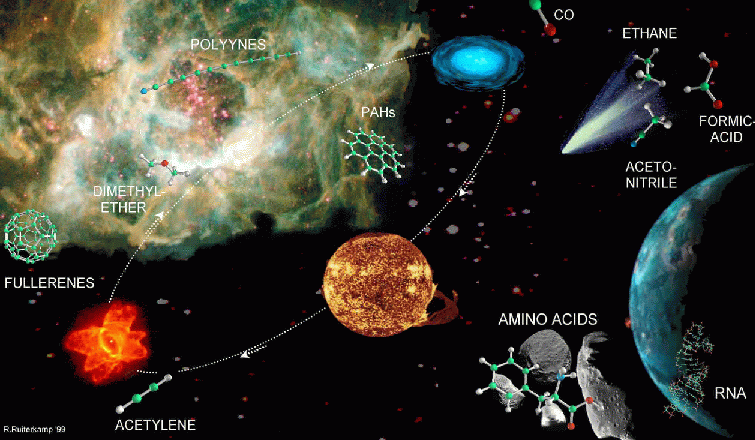
Astrobiology:
an Introduction to the Field.
The origin of stars and planetary
systems, and the possibility of life elsewhere in the Universe, have long fascinated
mankind. There is a broad understanding that life originated from simple precursor
molecules and proceeded via more complex molecules to self-replicating, metabolising
entities capable of independent existence and subsequent evolution. However,
the stages and mechanisms that comprise these processes are still poorly understood.
The biogenic elements (H, C, N, O, S, P) and organic matter are some of the
major constituents of the universe. Nucleosynthesis of heavy elements in stars,
such as carbon, allowed the formation of organic molecules, which are widespread
in our Galaxy and beyond. The discoveries of protoplanetary disks around other
stars suggested that our solar system is not longer the only known example of
a planetary system in the Universe. The hunt for planets resulted in the detection
of more than 50 planets to date circling other stars. Future instrumentation
in planetary detection might eventually show the existence of Earth-like planets
capable of sustaining life.
The geological record tells us that life on Earth began very quickly. The first
evidence for microbial life is provided by microfossils which are ~ 3.5 x 109
years old (planet Earth was formed ~ 4.5 x 109 years ago). During
the first billion years our planet provided very hostile conditions for life
to develop. Volcanic eruptions from the heated interior and external heavy bombardment
by small bodies may have extinguished emerging life on a rapid timescale.

Where and how did life originate ?
Numerous theories for the origin
of life exist which are based either on a terrestrial or an extraterrestrial
origin. For decades it has been suggested that organic chemistry in a reducing
atmosphere in Earth's early history triggered the formation of prebiotic molecules.
To date an idea of life's origin in the ocean is more favoured. The cycle of
water through ocean floor volcanic systems produces reducing conditions which
may lead to the formation of complex organic molecules. Another theory claims
that impacting prebiotic matter from comets and asteroids could have been the
first step to complex life. More than 120 major craters found on Earth prove
the importance of violent impacts from space. The progress in RNA chemistry
has strongly helped in reconstructing the "genetic tree" and in revealing steps
towards simple self-replicating systems. It has also been shown that life can
flourish in quite extreme environments. The research of hydrothermal systems,
permafrost, icy lakes and their inhabitants are a major focus in the field of
astrobiology and provide at the same time constraints for the search of life
on other planets in our solar system.
The major requirement for life - as we know it - are water, biogenic elements
and a source of energy (such as the Sun, geothermal energy, weathering of volcanic
rocks etc.). Apart from planet Earth there are currently three objects in our
solar system which may harbor ingredients for life, namely Mars, Europa and
Titan. The current Mars environment is too cold (and the atmosphere is too thin)
to retain liquid water on its surface. However, data from the Mars Pathfinder,
which landed successfully on Mars in July 1997 suggested widespread flowing
water in the previous history of Mars. Water could also be trapped as underground
ice on planet Mars. The moons Europa and Titan are major targets in the search
for liquids in the Solar System. Jupiter's moon Europa probably hosts a subsurface
water ocean beneath its outer ice crust. What geological processes create the
ice rafts and other ice-tectonic processes that are at the origin of prominent
surface features on Europa are currently strongly debated. Saturn's moon Titan
is of interest because of its atmospheric organic chemical activity. Titan may
also harbor a liquid hydrocarbon ocean.
Astrobiology is a new research field,
which studies the origin, evolution, distribution and destiny of life in the
Universe. This new discipline has been put forward through the establishment
of astrobiology centers and grants in the US and Europe.
In a series of workshops, the
aims and goals of the US astrobiology program have been defined and can be found
at http://astrobiology.arc.nasa.gov.
Astrobiology is a multidisciplinary research field, combining astronomy, astrophysics,
biology, biochemistry, chemistry, geology, climate research, and specific fields
such as palaeobiology, organic chemistry, geomicrobiology, ecogenomics (genome
evolution) and others. To understand life's origins in the context of planetary
environments, numerous space missions and space- and Earth-based experiments
are currently being carried out, or planned for the near future. Several space
missions organized by both NASA and ESA are in progress, or are well into the
planning stage, that have key objectives concerning the nature of extraterrestrial
organic chemistry and the search for traces of past or present life. These include
MARS-EXPRESS (to Mars), CASSINI-HUYGENS (to Saturn and Titan), ROSETTA (to comet
Wirtanen). Future space missions, such as more advanced Infrared satellites
(SIRTF, FIRST, NGST), an orbiter (or lander) to investigate Jupiter's moon Europa
(EUROPA-Orbiter) or space-based telescopes to search for Earth-like planets
(DARWIN, TPF-terrestrial planet finder) will build on and extend current mission
objectives for life search strategies. Answering the questions how life originated
on Earth is one of the main philosophical challenges of mankind and also of
vital importance in the frame of recent planetary detections and the possible
emergence of life elsewhere.
Astrobiology is a research field that is currently underemphasized in the Netherlands
compared to other large European countries and the US. It is therefore that
we organize a meeting to introduce this new research discipline on a national
basis, to stimulate collaborations and to form a young generation working on
future projects in this research field.
dr. Pascale Ehrenfreund,
Sackler Laboratory for Astrophysics, Leiden Observatory.
More links to astrobiology web sites are found at the Link
page.